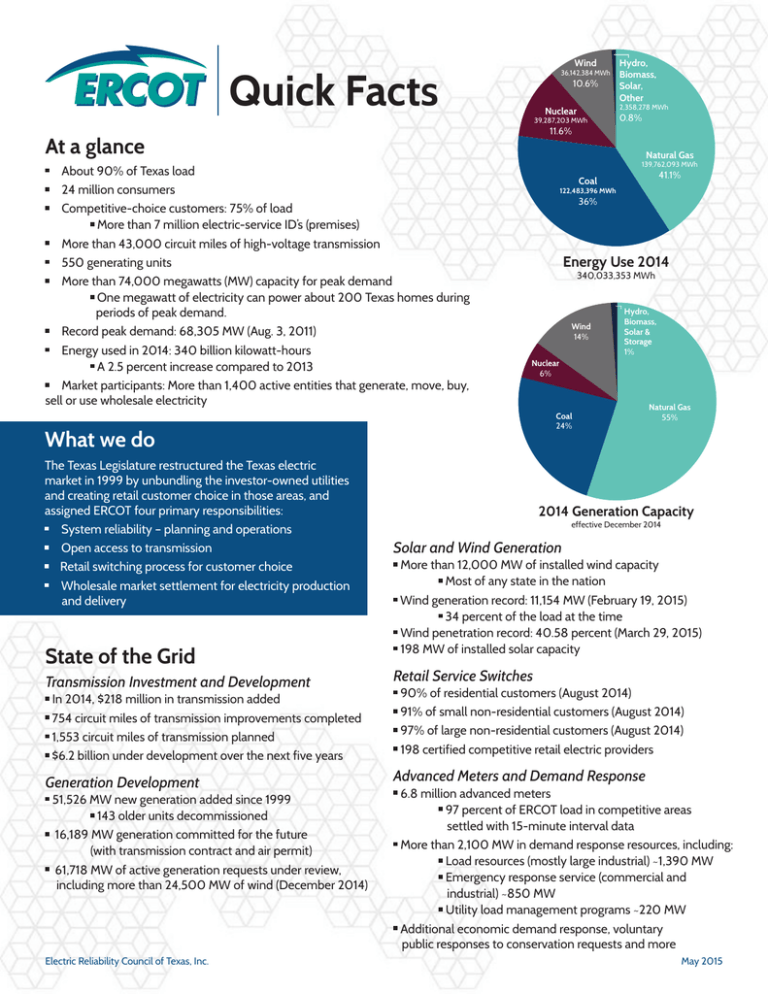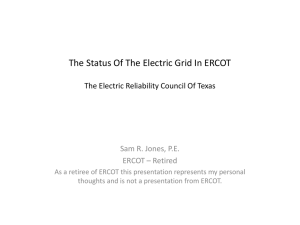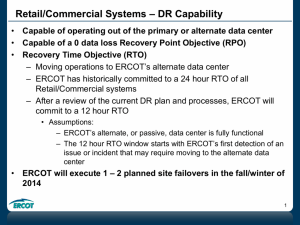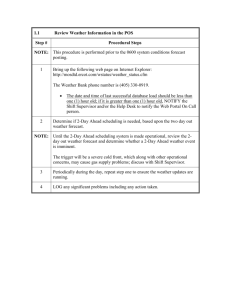Quick Facts At a glance
advertisement

Wind Quick Facts 36,142,384 MWh 10.6% Natural Gas 139,762,093 MWh In 2014, $218 million in transmission added 754 circuit miles of transmission improvements completed 1,553 circuit miles of transmission planned $6.2 billion under development over the next five years Generation Development 51,526 MW new generation added since 1999 143 older units decommissioned 16,189 MW generation committed for the future (with transmission contract and air permit) 61,718 MW of active generation requests under review, including more than 24,500 MW of wind (December 2014) Electric Reliability Council of Texas, Inc. 41.1% Coal 122,483,396 MWh 36% Energy Use 2014 340,033,353 MWh Wind 14% Hydro, Biomass, Solar & Storage 1% Nuclear 6% Coal 24% What we do Transmission Investment and Development 0.8% 11.6% About 90% of Texas load 24 million consumers Competitive-choice customers: 75% of load More than 7 million electric-service ID’s (premises) More than 43,000 circuit miles of high-voltage transmission 550 generating units More than 74,000 megawatts (MW) capacity for peak demand One megawatt of electricity can power about 200 Texas homes during periods of peak demand. Record peak demand: 68,305 MW (Aug. 3, 2011) Energy used in 2014: 340 billion kilowatt-hours A 2.5 percent increase compared to 2013 Market participants: More than 1,400 active entities that generate, move, buy, sell or use wholesale electricity State of the Grid 2,358,278 MWh Nuclear 39,287,203 MWh At a glance The Texas Legislature restructured the Texas electric market in 1999 by unbundling the investor-owned utilities and creating retail customer choice in those areas, and assigned ERCOT four primary responsibilities: System reliability – planning and operations Open access to transmission Retail switching process for customer choice Wholesale market settlement for electricity production and delivery Hydro, Biomass, Solar, Other Natural Gas 55% 2014 Generation Capacity effective December 2014 Solar and Wind Generation More than 12,000 MW of installed wind capacity Most of any state in the nation Wind generation record: 11,154 MW (February 19, 2015) 34 percent of the load at the time Wind penetration record: 40.58 percent (March 29, 2015) 198 MW of installed solar capacity Retail Service Switches 90% of residential customers (August 2014) 91% of small non-residential customers (August 2014) 97% of large non-residential customers (August 2014) 198 certified competitive retail electric providers Advanced Meters and Demand Response 6.8 million advanced meters 97 percent of ERCOT load in competitive areas settled with 15-minute interval data More than 2,100 MW in demand response resources, including: Load resources (mostly large industrial) ~1,390 MW Emergency response service (commercial and industrial) ~850 MW Utility load management programs ~220 MW Additional economic demand response, voluntary public responses to conservation requests and more May 2015 ERCOT Governance ERCOT Board of Directors Craven Crowell Chair (unaffiliated) Judy Walsh Vice Chair (unaffiliated) Tonya Baer Jack Durland Valero Services Inc. (industrial consumer) Keith Emery Kevin Gresham (unaffiliated) E.ON Climate & Renewables (independent generator) Mark Carpenter Clifton Karnei Oncor Electric Delivery (investor-owned utility) Read Comstock Direct Energy LP (independent retail electric provider) H.B. “Trip” Doggett President and Chief Executive Officer, ERCOT (ex-officio) (unaffiliated) Segment Alternates Tenaska Power Services Kristy Ashley (independent power marketer) Exelon Corporation (independent generator) Nick Fehrenbach Office of Public Utility Counsel City of Dallas (residential consumer, (commercial consumer) ex-officio) Jorge Bermudez Vacant Brazos Electric Cooperative (cooperative) Donna Nelson Chair, Public Utility Commission (ex-officio, non-voting) Mike Kezar South Texas Electric Cooperative Inc. (cooperative) Jean Ryall Porter CCNG Power (independent power marketer) Wade Smith American Electric Power (investor-owned utility) John Werner (unaffiliated) Source Power & Gas LLC (independent retail electric provider) Carolyn Shellman Phil Williams Karl Pfirrmann CPS Energy (municipal utility) Board, Stakeholder Process The ERCOT Board of Directors has general overall responsibility for managing the affairs of ERCOT, including approval of the budget and capital spending priorities, approval of revisions to ERCOT protocols and guides, and endorsement of major new transmission recommendations. ERCOT’s 16-member “hybrid” board includes five independent (or unaffiliated) members; three consumer segment representatives (industrial, commercial and residential); the ERCOT CEO; the Public Utility Commission (PUC) chairman (nonvoting), and six representatives from each of the industry segments – investor-owned utilities (or transmission owners), municipally owned utilities, cooperatives, generators, power marketers and retail electric providers. Under the Board’s oversight, ERCOT’s stakeholder process is responsible for developing policies, procedures and guidelines for power grid coordination, reliability and market operations. Denton Municipal Electric (municipal) ERCOT Officers H.B. “Trip” Doggett President & Chief Executive Officer Betty Day Vice President, Governance, Risk and Compliance Jerry Dreyer Sr. Vice President & Chief Information Officer Theresa Gage Vice President, External Affairs & Corporate Communications Brad Jones Sr. Vice President and Chief Operating Officer Bill Magness Sr. Vice President, General Counsel and Governance, Risk and Compliance Charles B. Manning, Jr. Chief Compliance Officer and Executive Advisor Mike Petterson Vice President and Chief Financial Officer Diane Williams Vice President, Human Resources Six standing committees and subcommittees supported by numerous working groups and task forces function within the stakeholder process. PUC, Legislative Oversight ERCOT is unique because its electricity grid is not synchronously connected outside of the state. Because of its separateness, ERCOT is primarily regulated by the Public Utility Commission of Texas (PUC) and the Texas Legislature, not federal authorities. The PUC approves the ERCOT system administration fee and has general oversight authority, including the ability to order audits. For most purposes, ERCOT, like the PUC, is accountable to the Texas Legislature and its jurisdictional committees. For federal reliability standards, ERCOT is accountable to the Texas Reliability Entity, the North American Electric Reliability Corporation, and the Federal Energy Regulatory Commission. The Electric Reliability Council of Texas (ERCOT) manages the flow of electric power to approximately 24 million Texas customers – representing about 90 percent of the state’s electric load. As the Independent System Operator for the region, ERCOT schedules power on an electric grid that connects more than 43,000 miles of transmission lines and 550 generation units. ERCOT also manages financial settlement for the competitive wholesale bulk-power market and administers customer switching for more than 7 million premises in competitive choice areas. ERCOT is a membership-based 501(c)(4) nonprofit corporation, governed by a board of directors and subject to oversight by the Public Utility Commission of Texas and the Texas Legislature. Electric Reliability Council of Texas, Inc. May 2015





